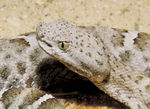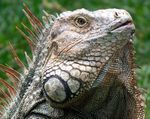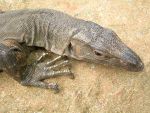


Toxicofera (Latin for "those who bear toxins"), is a clade which represents about 4600 species (nearly 60%) of Squamates; it encompasses all venomous reptile species, as well as numerous related non-venomous species.
Contents |
Details
Toxicofera combines the following groups from traditional classification:
- suborder Serpentes (snakes)
- suborder Iguania (anoles, chameleons, iguanas, etc.)
- infraorder
Anguimorpha, consisting of:
- family Varanidae (monitor lizards, including the Komodo dragon)
- family Anguidae (alligator lizards, glass lizards, etc.)
- family Helodermatidae (Gila monster and Mexican beaded lizard)
Background
In 2003 groundbreaking work by Dr. Bryan Grieg Fry was published that showed nearly all "non-poisonous" snakes produce venom to a certain extent. This suggested a far more ancient origin for venom in Serpentes than had been considered until then, laying the foundation for future research.
Before the publication of the Toxicofera hypothesis, venom in Squamates was only known in Serpentes and Helodermatidae. Part of the original research that led to the venom clade was the discovery of venom (or venom genes) in species from groups (Iguania and Varanidae) which were not previously known to produce it (Anguidae was included in the venom clade for phylogenetic reasons).
Toxicofera was described simply as the "venom clade" when first proposed to the scientific community by Fry, et al, in the Journal Nature in 2005. It was given a formal name by his associates, Vidal and Hedges, in the Journal Comptes Rendus Biologies (CR Biologies) the same year.
Conclusions
It was estimated that the common ancestral species that first developed venom in the venom clade lived on the order of 200 million years ago, approximately 100 million years before snakes evolved.
The venoms are thought to have resulted after genes normally active in various parts of the body duplicated and the copies found new use in the salivary glands.
The newly discovered diversity of Squamate species producing venoms is a treasure trove for those seeking to develop new pharmaceutical drugs; many of these venoms lower blood pressure, for example.
External links
- Venom Hunt Finds 'Harmless' Snakes A Potential Danger December 16, 2003
- Lizards' poisonous secret is revealed November 16, 2005
- The Surprising Origin of Venom Revealed November 17, 2005
- Which Came First, the Snake or the Venom? November 21, 2005
- Genealogy of scaly reptiles rewritten by new research November 22, 2005
Papers
- Molecular Evolution and Phylogeny of Elapid Snake Venom Three-Finger Toxins July 2003
- The phylogeny of squamate reptiles (lizards, snakes, and amphisbaenians) inferred from nine nuclear protein-coding genes Available online October 27, 2005
- Early evolution of the venom system in lizards and snakes Available online November 16, 2005
Dr. Fry
- Homepage
- The Venom Cure: The Power of Poison
- Dr. Fry's Near Fatal Attraction
- Nature Podcast November 17, 2005 (Dr. Fry's segment on Komodo dragons begins 22 minutes into the program)